Plant description
S
ought after by plant collectors around the world, the Pink Princess philodendron is a variegated philodendron with creamy pink, fuschia and deep green leaves. Its scientific name, “erubescens”, is Latin for blushing, and you can find this plant in a range of rosy shades to suit your taste.
While a standard Pink Princess isn’t too difficult to find, they are typically a more expensive than other houseplants due to their variegation (a characteristic which means they grow more slowly than non-variegated houseplants and are more delicate). Rare plant breeders select for excotic, brightly colored variegation patterns in Pink Princess plants and sell them for a small fortune, but you can find more subtly variegated species of Pink Princess at local nurseries that cost just a bit more than your average philodendron.
But where does the pink color come from? The pink areas on this plant do not contain chlorophyll, the green pigment that absorbs light and transforms it into energy found in the green portions of leaf. Although wildly variegated Pink Princess plants can be stunning, leaves containing too little chlorophyll are bad for the plant’s health.
Most Pink Princess leaves either display a splatter pattern or a half-pink, half-green coloration. These patterns typically indicate stronger plants than fully pink and white specimens, since they contain more chlorophyll to meet the plant’s energy requirements.
Plants that grow fully pink and cream leaves are easily sunburned and often lack structure due to their lessened capacity for harnessing energy from sunlight.
Despite the fussiness around light (we are dealing with a Princess 👸 after all!), your average Pink Princess philodendron is actually quite easy to care for. They are native to the understory of Central American rainforests, and are used to growing in shade with a layer of rich topsoil to feed them.
Pink Princess philodendrons need a little more fertilizer than some other plants, but they don’t need much water or direct sunlight. If you get your hands on one of these collector’s gems, a little attention will go a long way in keeping your plant producing vibrant pink leaves for many years.
PRO TIP: This rare plant makes a great gift for plant lovers. 😉
Plant facts
| common names | Pink Princess Philodendron |
| botanical name | Philodendron erubescens |
| no. of species | N/A |
| family | Araceae |
| biological life cycle | Perennial |
| foliage | Simple leaf |
| mature size | Up to 2 feet tall without a pole, up to 6 feet tall as a climber |
| time to maturity | 6-12 months |
| origins | Central America, Colombia |
| light conditions | Medium to bright indirect light |
| soil type | Loamy, well-draining |
| water ph | 5.5-6.5 (Slightly acidic) |
| usda zone | 10-12 |
| toxicity | Toxic to pets and humans |
Popular Varieties/Related Plants:
Varieties include: Sparkle, Marble, Pink Congo, Black Cherry, Strawberry Shake
Maintenance
Aside from its rather fussy lighting requirements, Pink Princess philodendrons are relatively low-maintenance. They’re shade-tolerant, although they do best in medium to bright indirect light, and they don’t need too much water. Since they’re used to nutrient-rich rainforest topsoil, they like a little more fertilizer than average in a soil that drains well and dries out between waterings. This plant generally likes to do its own thing and enjoys showing off its foliage for all to see!
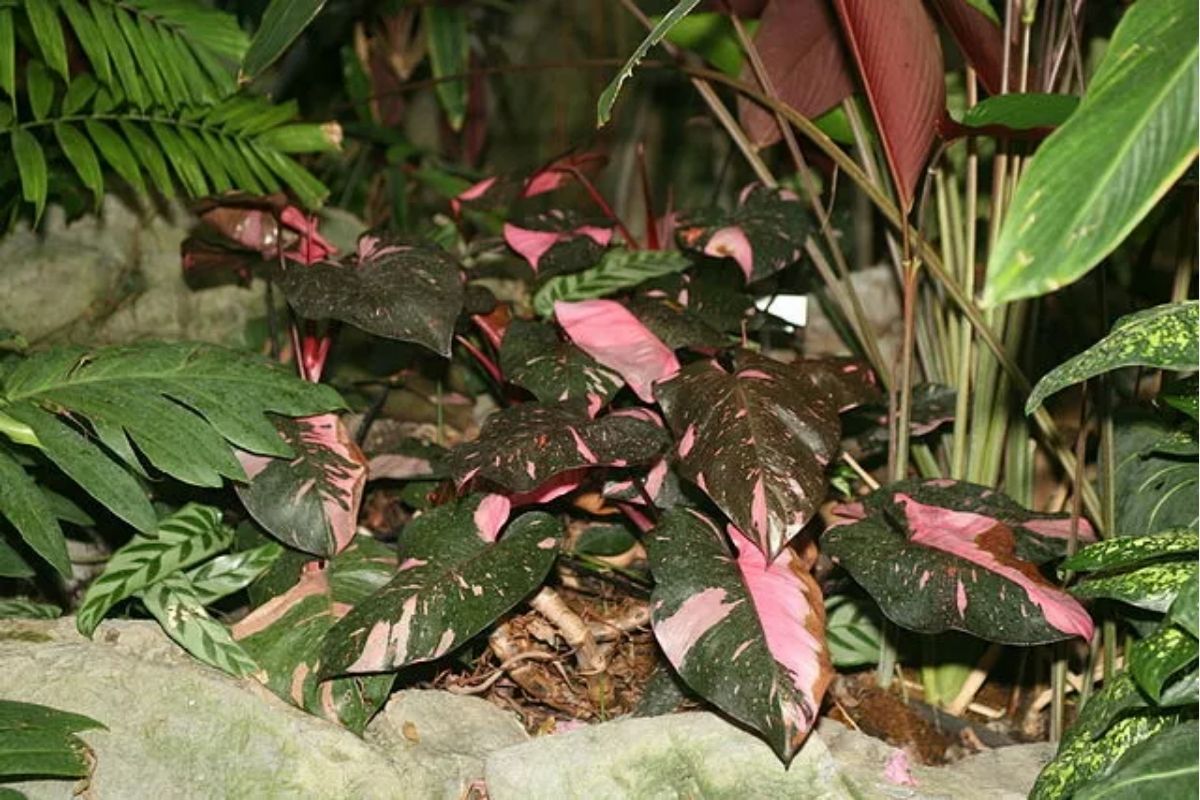
Light 🔆
Best light: Medium to bright indirect light
While the overall variegation pattern is a genetic trait, your Pink Princess plant will produce varying degrees of colorful variegation depending on the light it receives. Brighter light conditions will encourage your plant to produce more pink leaves because sun energy is abundant, and fewer cells containing chlorophyll will do the job of fueling the plant.
If you move your plant to a darker corner or winter rolls around, you might notice your Pink Princess producing more green leaves in an effort to capture more of the limited supply of sunlight. As a native to the forest floor, Pink Princess philodendrons do best in medium to bright indirect light. Avoid placing this plant in direct sunlight, especially during midday; this exposure can burn the plant’s leaves.
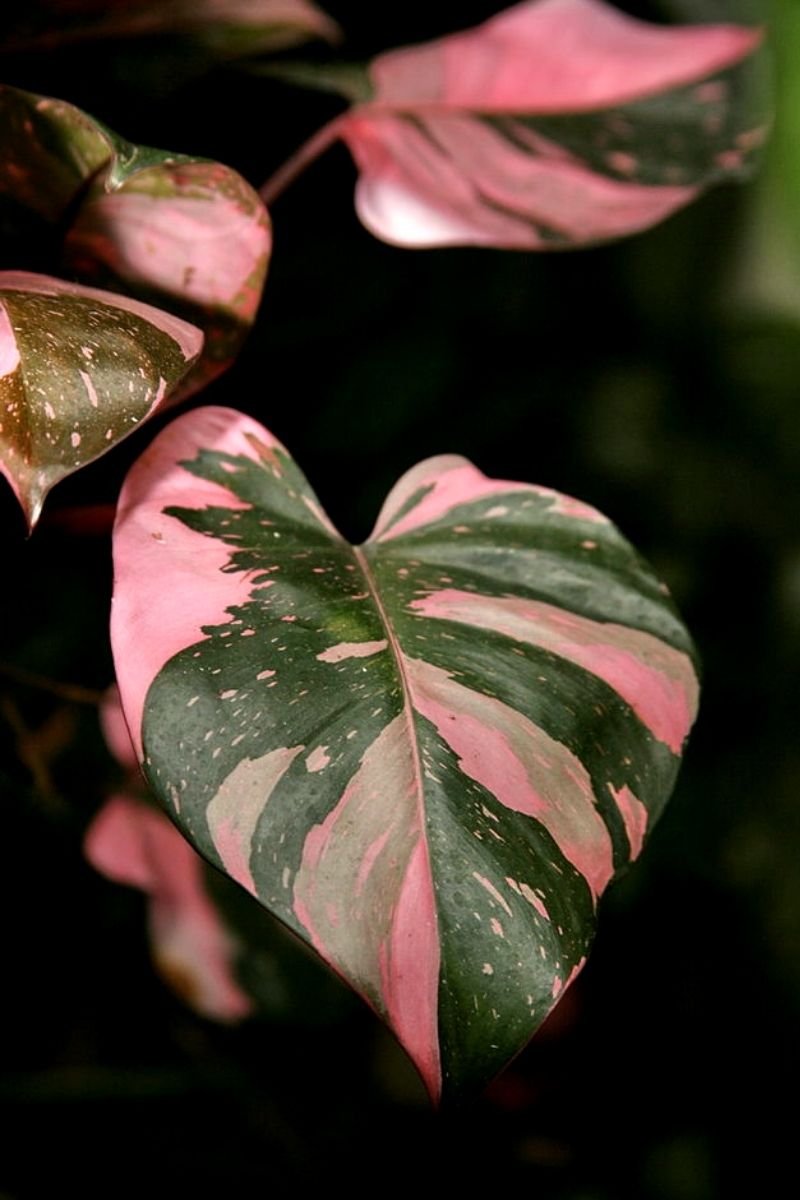
There’s a fine balance here: Excess light exposure will discourage chlorophyll production, and can result in weak leaves – especially if your plant is lacking other essential nutrients in soil. As long as your Princess isn’t too stressed, it should produce the beautiful range of pink and green leaves that it’s loved for.
Water 💧
Water needs: Once every week or a week and a half
This Princess isn’t too picky when it comes to water, fortunately! As a climbing vine, this philodendron has aerial roots that draw moisture from the air in addition to grounded roots that sip up water from the soil. Generally, it’s best to water your Pink Princess once every week or a week and a half, allowing the soil to dry out completely between waterings. The leaves will curl if they aren’t getting enough water. Too much water, on the other hand, can cause brown blemishes on this plant’s gorgeous leaves and threaten its shallow, fibrous roots with root rot.
Humidity 🌫️
As a tropical plant, the Pink Princess philodendron enjoys about 50% humidity. It should be comfortable in pretty much any home. However, your Pink Princess may appreciate a humidifier or an occasional spray from a water bottle if you have one. If you notice new growth on your Pink Princess looking dry or weak, your plant is probably dehydrated and could use a boost of humidity.
Temperature 🌡️
Pink Princess philodendrons are used to a warm climate, and they like temperatures that are above 60 degrees. During the winter, be sure to keep them out of drafty areas. In the summer, the plant will thrive in higher temperatures and bright, long days, but be sure to keep its delicate foliage away from direct sunlight.
Fertilizer 💩
This plant’s roots evolved to take advantage of the nutrient-dense, bioactive topsoil of the rainforest floor, so they like fertilizer a little more frequently on average than other plants. Give your Pink Princess small amounts of liquid fertilizer every two or three weeks with regular watering during the spring and summer when they’re actively growing. If you tend to forget to fertilize your plants, granular or organic fertilizers are a good idea. Give your Princess one serving of either at the beginning of spring and another at the beginning of summer to decrease applications while ensuring your plant gets a consistent supply of the nutrients it needs.
Soil
The shallow, fibrous roots of philodendrons are used to the uppermost level of topsoil in their native forest habitat, which dries out quickly after a rain. The best soil for a Pink Princess philodendron drains well and retains some moisture. When choosing a soil type for your philodendren, look for loamy soil that contains both clay and sand, and other solid materials like bark and perlite. The Pink Princess is a great candidate for LECA since it needs nutrients regularly and enjoys dry soil conditions. It’s pretty easy to learn how to grow your plant in LECA – just make sure you have the right supplies before transferring your plant to this new soil medium.
Soil Type: Loamy, well-draining
pH level: Slightly acidic (5.5-6.5)
Repotting
When your Pink Princess gets too large for its pot, either becoming root-bound or side-heavy, repotting the plant is a pretty easy process. Be sure the new pot isn’t too large, since pots with too much space and soil hold on to water longer and can damage the plant’s roots. The pot should have drainage holes as well. Terra cotta pots are a good choice for good drainage. Pink Princess philodendrons are somewhat slow-growers, and should only need to be repotted once every few years.
Propagation 🌱
Since Pink Princess plants can be slightly hard to come by, propagation by stem cuttings is an easy way to make the most of this super gift-able, gorgeous pink plant. Simply clip a section of stem containing 2-3 leaves beneath an aerial root node, and place in water. Once the stem has grown roots about 3 inches long, transfer to a small pot with fresh soil, and water regularly.
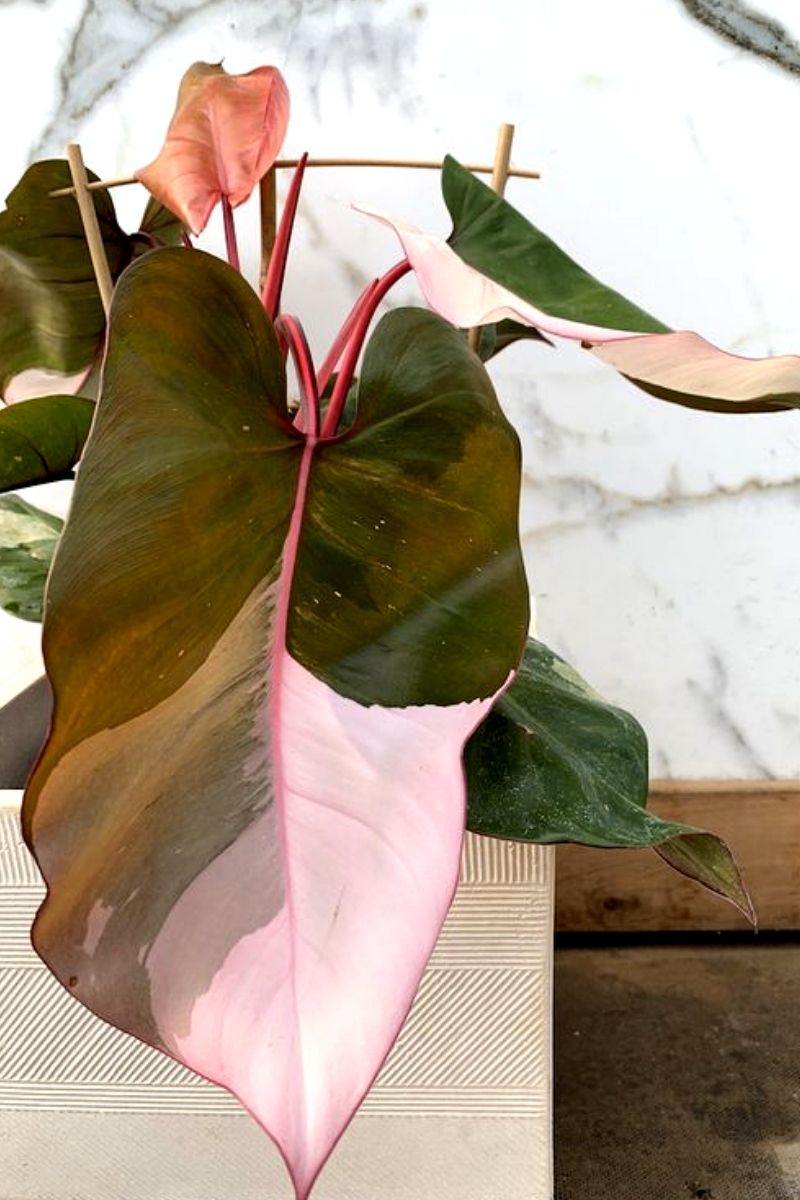
Pruning 🌿
Pruning plays an important role in keeping your Princess, well – pink! When you snip off old leaves or clip some off to propagate, the other leaves on the plant will receive more light, and new leaves will grow to fill in the space. Pruning with care can encourage your Pink Princess to grow more densely and produce new variegated leaves with different pink and green patterns. Some young leaves come in as an almost black color, which may or may not fade as the leaf matures.
Pests and diseases 🐛
The Pink Princess philodendron isn’t super susceptible to pests, but it can attract thrips or mealy bugs that like the plant’s waxy leaves.
Overwatering is a bigger concern with Pink Princess plants, since their roots are easily damaged by too much moisture. A lack of oxygen in the soil can prevent the plant from absorbing nutrients, and waterlogged soil can lead to root rot (you can learn how to fix root rot, but it can quickly kill plants if you let it go too far). Fungal growth and gnats follow soil that’s heavy with moisture, so it’s a good idea to change your plant’s potting soil if you go way overboard with water by mistake.
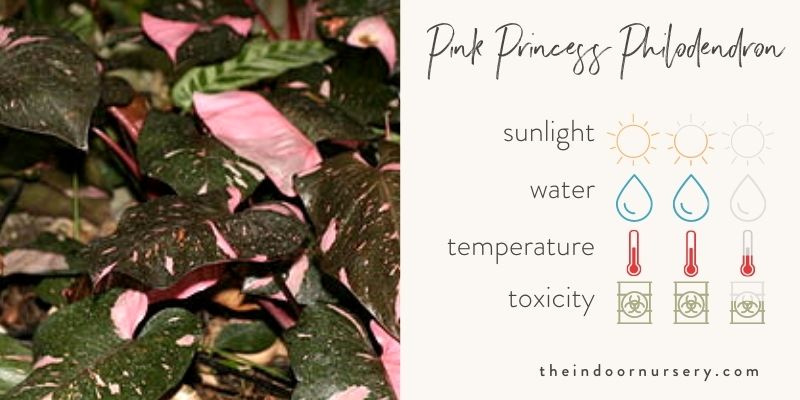
Plant care tips
- How to encourage pink coloration on your Pink Princess philodendron. A healthy, mature Pink Princess philodendron will produce leaves with various amounts and patterns of pink, which will change from leaf to leaf. Many plant Pink Princess plant parents obsess over striking the perfect lighting balance to get the desired variegation. You want enough indirect light to get leaves with pretty splashes or patches of pink, and the right amount of shade to keep the plant producing enough chlorophyll-rich green leaves to stay healthy. When the plant gets enough light, it makes less chlorophyll because the solar energy source is plentiful; the spots without chlorophyll show on this plant as pink.
- Grow your Pink Princess vertically on a moss pole. The Pink Princess is a climbing vine, true to the philodendron nature. Purchasing a moss pole is a great way to encourage your plant to grow vertically, providing it with a stable structure and source of moisture in the moss. Moss poles are also pretty easy to make with a few supplies. Learn how to make your own moss pole!
Common Problems / FAQs:
Why aren’t the Pink Princess leaves fully pink?
When a Pink Princess philodendron puts out a fully pink leaf, it may be beautiful, but the leaf doesn’t produce any chlorophyll and can’t survive very long. If the plant has lots of strong leaves otherwise and a good balance of indirect light, a fully pink leaf may stay around for a while, but will eventually either revert to green or wilt from a lack of energy. The Pink Congo variety puts out more solid pink leaves than other varieties, but they are known to change colors frequently.
What you can do when the leaves turn green?
If your plant leaves are reverting to green, don’t worry! This is a temporary measure to store more chlorophyll, and is a sign the plant could use more light. Move the plant into a better lit area, and it should regain its pink variegation.
Shop our recommendations
- The Best Hydroponic Tower For Indoor Gardening
- 10 Best Worm Composter Bins For Easy Homemade Compost
- The Best pH Meter For Soil
- The 6 Best Dehumidifiers For Grow Tents
- The Best Complete Indoor Hydroponic Grow System
- 5 Best Grow Light Strips For Indoor Plants
- TESTED: Aerogarden vs Click and Grow Smart Garden
- Our *hands on* MARS HYDRO TSW 2000 review (with photos)
- 7 Best Hygrometers For Indoor Plants
- The Best Coco Coir For Your Plant’s Healthiest Root System Ever
Source: Pinterest

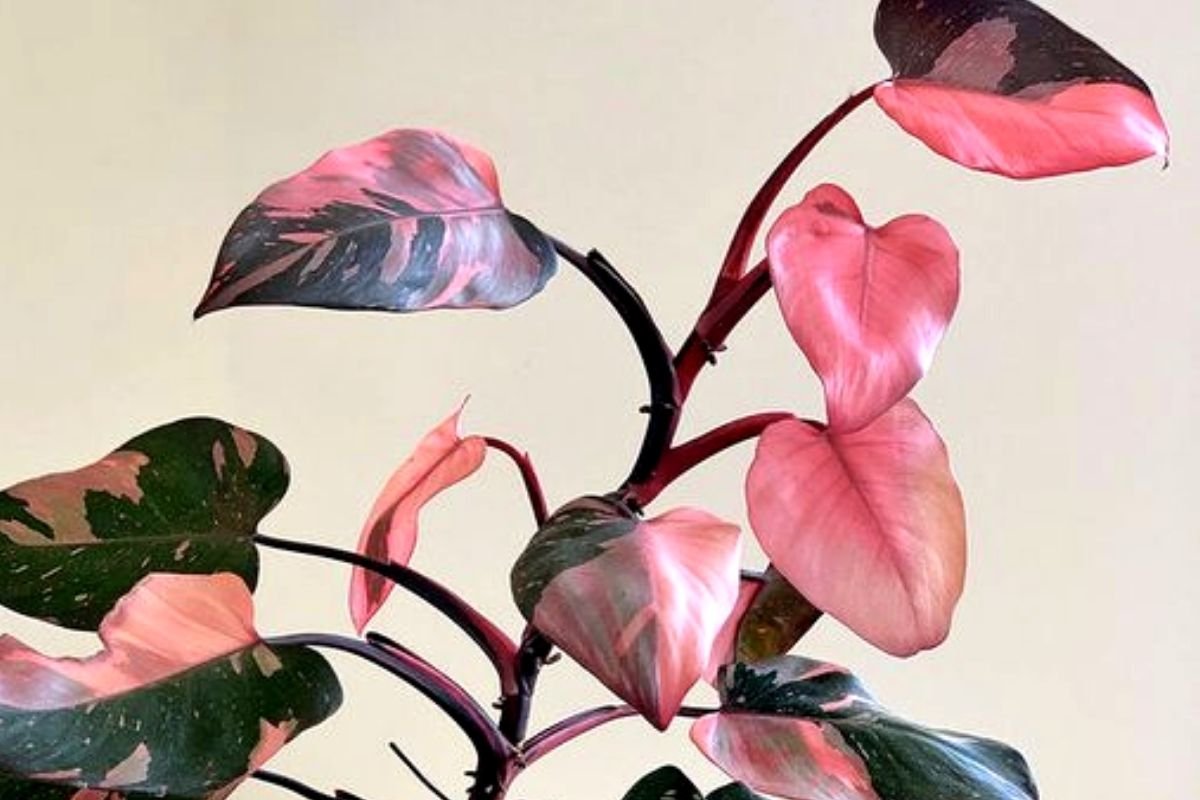
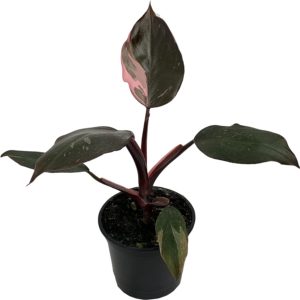



Hey, Marcia! Thanks for reading :) gosh, that's a great idea to double up on your watering globe and spike.…